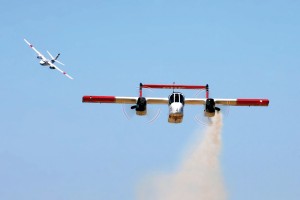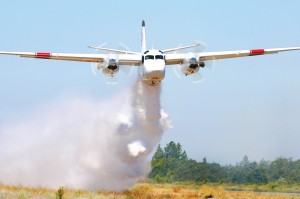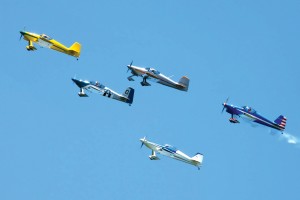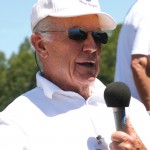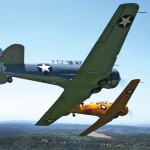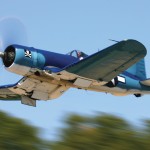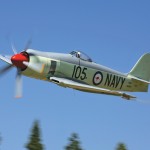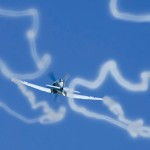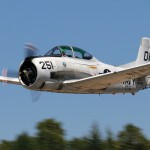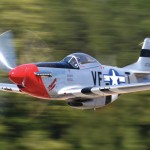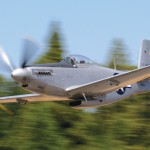By Victor G. Archer
Hidden in the Sierra Nevada Mountains, nestled within the forests of scenic gold country, is the little town of Grass Valley, Calif., home to Nevada County Airport (GOO) and the annual Nevada County AirFest.
The 30th annual festival, held July 7, featured a great variety of aircraft from the past and present, everything from new, light sport kit planes to vintage fighters and trainers from World War II.
CalFire, the recently re-named California Department of Forestry and Fire Protection, started the show with a formation flyby of a North American Rockwell OV-10 Bronco air-tactical plane and a Grumman S-2T Tracker air tanker. CalFire performed an aerial fire suppression demonstration on the next pass. The OV-10 made a low-level pass and left a smoke trail to direct the incoming S-2T. Then, the tanker made a pass right between the runway and taxiway and dropped approximately 1,000 gallons of water right down the center, displaying the result of excellent cooperation between the two aircraft.
The Golden Empire Flying Association and local Experimental Aircraft Association Chapter 1175 are among the many groups of aviation enthusiasts that utilize the airport. Several members displayed homebuilt aircraft, many built right in Grass Valley. After the CalFire demonstration, many of the local aircraft went up for flybys.
This group included an Excalibur and three Challenger ultralights, and representing light-sport aircraft kit planes, a beautiful 2006 Jabiru USA Sport Aircraft J250-SP and a TL-Ultralight Sting Sport, both powered by the popular Bombardier-Rotax engines.
Kit planes with a little more power included a 1982 Rutan Long EZ, powered by a 115-hp Lycoming I0-235, which went up with a pair of Van’s RV-6s. Keith Peterson’s 2002 Lycoming IO-540-powered Harmon Rocket, Jack Rouse’s 1988 Lycoming IO-540-powered Glasair III, Gary Rudolph’s 2003 Continental IO-550-powered Lancair Legacy and Arnis Luters’ Walter 601D-powered Legend, Miss Ginger, all went up and made some very fast passes over the field.

Lynn Kerby’s TL-Ultralight Sting Sport is an example of the new light-sport aircraft class of kit planes now available.
An unannounced visit by Gen. Chuck Yeager was a treat for visitors. A large crowd gathered to listen as Yeager told of firsthand experiences dogfighting and testing aircraft. After flying combat missions during WWII, Yeager was one of the first test pilots to fly jet and rocket-powered aircraft. He went into detail about the development of the Bell X-1 project, and how he became the first person to break the sound barrier, on Oct. 14, 1947.
Performing next, as a step back in time, were training aircraft of WWII. First, a pair of Consolidated Vultee Valiants went up in formation. The lead plane was a 1945 Convair BT-15, piloted by Ken Borman. Flying in the wingman position was Mark Klein in his 1942 Vultee BT-13B (SNV-2). During WWII, the production run of 11,000 Valiants outnumbered all other basic trainer types produced.
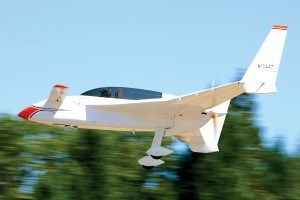
The Long EZ is one of the most unique-looking kit aircraft. David Bernasconi of Grass Valley owns and pilots this one.
Jim Booth, in his Canadian-built Harvard Mk. IV (AT-6), MYT-6, led a group of North American T-6/SNJ trainers. Booth, Robert Lessman, Ken Dwelle and Marvin Quaid made several passes over the field, changing the formation on each pass.
A pair of more modern training aircraft then went up for a few passes. David King and Harold Morley flew Chinese-built Nanchang CJ-6As. A group of four North American T-28 Trojans followed; Eugene Choiniere’s 1958 T-28C, Daniel Dugan’s T-28B, Tom McGee’s 1955 T-28B and Scott Stephen’s T-28A all made a few passes over the flight line.
Soon it was time for the warbirds. Terry Tarditi’s 1944 North American P-51D-25NA Mustang, Mike Coutch in his very rare 1944 P-51H-5NA Mustang, Chuck Wentworth piloting his Goodyear FG-1D Corsair and Ellsworth Getchell in his Bristol Centaurus-powered Hawker Sea Fury Mk.II all went up together and made several passes. These three aircraft type represent the diversity in development of WWII fighter aircraft. Tarditi and Coutch flew their Mustangs fast and low. Wentworth circled around from behind the crowd and showed off the unique lines of his Corsair. Getchell got the crowd going by circling around, climbing out very high and then diving on the field, aiming straight at the spectators before banking away. Smoke generators on his wingtips added to the drama.
For those looking for an air show in a unique setting, this is the place. Lots of great food, local vendors, classic cars and a diverse display of aircraft all converged on this small town airport. With tall trees surrounding the airport and bright blue skies, it’s easy to see why this one-day show has become one of the best small-town fly-ins in the U.S.
- A large crowd listened as Gen. Chuck Yeager, who made a surprise visit to the Nevada County Airfest, talked about his experiences.
- Marvin Quaid’s beautifully restored 1944 North American AT-6F was originally built for the U.S. Army Air Force as 44-82027.
- Jim Booth takes the lead position as the T-6 formation flight heads toward the field.
- A pair of 1940s Consolidated Vultee Valiants makes a formation flyby. Ken Borman leads the way in his 1945 Convair-built BT-15. Flying off his wing is Mark Klein in his 1942 Vultee BT-13B.
- Chuck Wentworth takes off in his Goodyear FG-1D Corsair.
- Ellsworth Getchell makes a low and slow approach past the flight line in his British Hawker Sea Fury.
- Ellsworth Getchell, with smoke generators on the wingtips of his Sea Fury, showed guests what wake turbulence looks like.
- Eugene Choiniere makes a pass in a 1958 North American T-28C Trojan.
- Terry Tarditi’s 1944 North American P-51D-25NA Mustang, Comfortably Numb, was once owned by Pink Floyd band member David Gilmore.
- Mike Coutch’s rare 1944 P-51H-5NA is one of only five remaining H model Mustangs.












